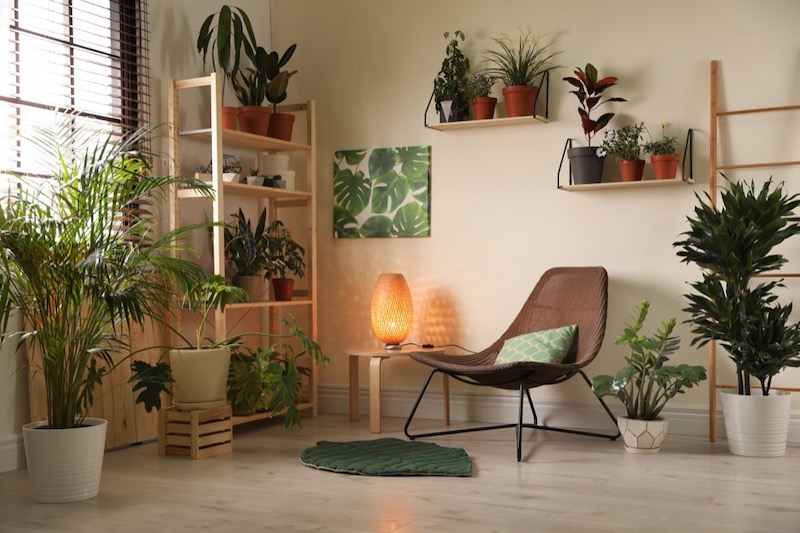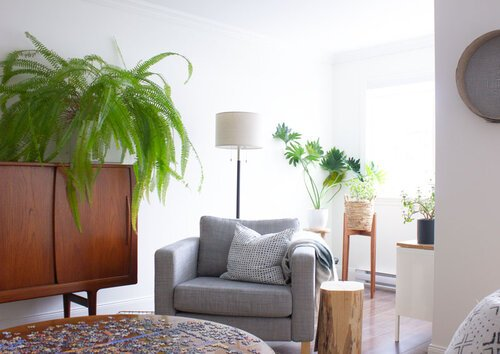In today’s fast-paced world, unwinding and prioritizing mental well-being is crucial. Fortunately, your home can be a refuge, a space designed to promote relaxation and reduce stress. This blog delves into elements for crafting a calming environment, fostering a sense of tranquility, and supporting your overall well-being.
The Power of Place:
Our environment holds immense power over our mental and emotional state. Research suggests a direct correlation between the design of our living spaces and our well-being. Studies have found that a well-designed home can:
Reduce stress hormones: One study published in the Journal of Environmental Psychology found that individuals in organized, clutter-free environments experienced lower levels of the stress hormone cortisol compared to those in cluttered spaces.
Improve sleep quality: Exposure to natural light during the day helps regulate the body’s natural sleep-wake cycle. Conversely, artificial blue light emitted from electronic devices can disrupt sleep patterns. A 2017 study published in Sleep Health suggests that reducing exposure to blue light before bed can significantly improve sleep quality.
Enhance cognitive function: A research review published in Frontiers in Psychology highlights the link between organized and aesthetically pleasing environments and improved cognitive performance.
Harnessing the Light:
Natural light acts as a natural mood elevator. To harness its power and create a calming environment, consider these strategies:
Strategic Furniture Placement: Arrange furniture to maximize natural light exposure. Position key pieces like couches, armchairs, and even your desk near windows. It allows ample sunlight to bathe the space, fostering a bright and inviting atmosphere.
Sheer Curtains: Embrace Gentle Diffusion: Opt for sheer curtains that gently filter incoming sunlight. It allows natural light to permeate the room while maintaining privacy. Avoid heavy drapes or dark blinds that block out the sun’s natural rays.
Creating a Light and Airy Feel: By maximizing natural light, you create a sense of spaciousness and airiness. It, in turn, promotes feelings of well-being and reduces feelings of being closed in.
The Power of Evening Light
As the day progresses, create a shift towards a more calming ambiance:
Embrace Dimmers: Install dimmers on your light switches. It allows you to gradually reduce the intensity of overhead lighting as the sun sets, creating a more relaxed atmosphere.
Soft Lighting Fixtures: Choose table lamps and floor lamps that emit soft, diffused light. Opt for lampshades made of natural materials like fabric or woven materials, as they tend to cast a warmer glow.
Warm-Toned Bulbs (2,700 Kelvin): Replace harsh white bulbs with warm-toned bulbs around 2,700 Kelvin. This color temperature mimics the warm glow of sunset, signaling to your body that it’s time to wind down and prepare for sleep.
Mimicking Nature’s Cues: The gradual decrease in light intensity as the day progresses mimics the natural cycle of sunset. By incorporating these lighting strategies, you can create a similar effect, promoting relaxation and preparing your body for a restful night’s sleep.
Soothing the Senses:
Our senses play a crucial role in shaping our perception of the environment and impacting our emotional state. To cultivate a calming space, consider these elements that directly target the senses:
Combating Visual Clutter:
Visual clutter can be overwhelming and create a sense of mental disarray. De-cluttering your space regularly is vital. It involves:
Regular Decluttering Sessions: Schedule regular decluttering sessions to go through belongings and discard anything unused, broken, or that no longer brings joy.
Designated Storage Solutions: Utilize storage solutions like baskets, cabinets, and shelves to neatly organize items, keeping surfaces clear and reducing visual chaos.
Mindful Display: Display personal items intentionally. Opt for a minimalist approach, showcasing a few cherished objects that evoke positive memories or inspire you.
The Calming Power of Color:
Colors significantly influence our moods and emotions. To promote feelings of tranquility, consider incorporating calming color palettes:
Neutral Tones: Opt for neutral tones like beige, light greys, or soft greens. These hues create a sense of peace and serenity, acting as a blank canvas for bolder accent pieces.
Cool Colors: Cool colors like pale blues or lavender are naturally calming. They can evoke feelings of tranquility and create a sense of spaciousness in a room.
Mindful Application: While bold colors can have their place, use them sparingly. Consider incorporating them as accent pieces like throw pillows or artwork to add visual interest without overwhelming the senses.
Embrace the Biophilic Connection:
Studies from the field of biophilia, the human connection with nature, suggest that interacting with natural elements reduces stress and improves mood. Here’s how to incorporate nature’s calming influence:
Houseplants: Surround yourself with houseplants. Caring for them not only adds a touch of life to your space but also purifies the air and reduces stress levels. Choose low-maintenance varieties like snake plants or spider plants for beginners.
Natural Materials: Incorporate natural materials like wood, stone, and woven textures into your furniture and decor. These elements bring a sense of the outdoors into your home and create a more grounded and calming atmosphere.
Nature Soundscapes: Consider incorporating nature sounds like babbling brooks, ocean waves, or gentle rain. These auditory cues can mask unwanted noise and promote relaxation.
Aromatherapy:
Our sense of smell plays a powerful role in influencing our mood and emotions. Aromatherapy, the practice of using essential oils for therapeutic purposes, can be a valuable tool in creating a calming atmosphere.
Essential Oils for Relaxation:
Certain essential oils possess properties known to promote relaxation and reduce stress:
Lavender: Widely recognized for its calming properties, lavender oil is known to ease anxiety and promote feelings of well-being.
Chamomile: This gentle oil possesses calming and sedative effects, promoting relaxation and restful sleep.
Bergamot: Extracted from the rind of the bergamot orange, this oil has uplifting and calming properties, helping to ease tension and anxiety.
Diffusion Methods:
Several methods exist for diffusing essential oils:
Ultrasonic Diffusers: These electric diffusers utilize ultrasonic waves to break down essential oils into a fine mist, gently dispersing the scent throughout the room.
Nebulizer Diffusers: Nebulizers use compressed air to atomize essential oils, creating a powerful and concentrated mist. Due to the high concentration, these diffusers are best suited for larger spaces and should be used with caution.
Passive Diffusion: Apply a few drops of essential oil to a cotton ball or diffuser pendant and place it discreetly around the room. This method provides a subtle and long-lasting fragrance.
Choosing a Diffuser:
Consider these factors when selecting a diffuser:
Room Size: Select a diffuser suitable for the size of the room you wish to fragrance.
Noise Level: Opt for a diffuser with a quiet operation, ensuring it doesn’t disrupt relaxation.
Automatic Features: Some diffusers offer features like automatic shut-off timers and adjustable mist settings for optimal control of the diffusion process.
Important Considerations:
Dilution is Key: Essential oils are highly concentrated and can cause skin irritation if applied directly. Always dilute them with a carrier oil like jojoba or almond oil before topical application.
Consult a Healthcare Professional: While generally safe for most individuals, some essential oils can interact with medications or exacerbate certain health conditions. It’s crucial to consult with a healthcare professional before using essential oils, especially if you have any underlying health conditions or are pregnant or breastfeeding.
Quality Matters: Invest in high-quality, therapeutic-grade essential oils from reputable sources. It ensures the oils are pure and free of contaminants.
Soundscapes for Serenity:

Our sense of hearing significantly impacts our emotional state. Creating a soundscape specifically designed to promote relaxation can be incredibly effective:
White Noise Machines:
Invest in a white noise machine that generates ambient sounds like:
Ocean Waves: The rhythmic crashing of waves evokes feelings of peace and tranquility.
Gentle Rain: The pitter-patter of raindrops creates a calming and soothing atmosphere.
Forest Sounds: The sounds of rustling leaves and birds chirping can transport you to a natural environment, promoting relaxation and reducing stress.
Nature Soundscapes:
Utilize online resources or nature sound apps to play soundscapes featuring:
Babbling Brooks: The gentle gurgling of a stream can be incredibly calming and mask unwanted noise.
Soft Breezes: The subtle whoosh of wind can create a sense of peace and tranquility.
Mindful Music Selection: While not strictly a “soundscape,” incorporating instrumental music with slow tempos and calming melodies can enhance the relaxing ambiance. Opt for genres like classical music, nature soundscapes with music overlays, or binaural beats specifically designed for relaxation.
Crafting Comfort:
Incorporating elements that provide physical comfort can significantly elevate the overall calming effect of your space:
Plush Throws and Cozy Pillows: Invest in soft throws and comfortable pillows made from natural materials like cotton or wool. These items provide a sense of warmth and physical comfort, inviting you to sink in and relax.
Textural Delight: Introduce different textures to enhance the sensory experience. Consider knitted throws, faux fur cushions, or soft chenille blankets. It adds visual interest and provides a tactile element that can further promote relaxation.
Ambient Lighting: Combine soft lighting fixtures with the strategic placement of lamps. It allows you to adjust the light level based on your needs, creating a warm and inviting relaxing atmosphere.
Designating a Relaxation Zone:
Carve out a dedicated space in your home solely for relaxation and self-care. This could be:
A Cozy Reading Nook: Create a comfortable corner with a comfy armchair, a side table for your book, and a reading lamp.
A Meditation Corner: Equip a quiet space with a yoga mat, meditation cushions, and calming visuals like mandalas or nature photographs.
A Tranquil Window Seat: Position a comfortable chair by a window, allowing natural light to bathe the space. Add soft pillows and a throw for additional comfort.
Technology Timeout:
The constant stimulation and blue light emitted from electronic devices can significantly hinder relaxation. To cultivate a calming space, consider:
Establishing Technology-Free Zones: Designate specific areas in your home, particularly your relaxation zone, as technology-free zones. It allows you to fully disconnect from the digital world and focus on activities that promote relaxation and self-care.
Setting Time Limits: Set specific times during the day or evening when you will refrain from using electronic devices. It creates a designated “unwinding” period where you can prioritize relaxation and mental well-being.
Alternatives for Relaxation: Explore alternative activities that promote relaxation like reading a book, taking a warm bath, practicing mindfulness exercises, or spending time in nature.
Remember:
Creating a calming space is an ongoing process. Experiment with different elements and find what works best for you.
By incorporating these tips and tailoring them to your personal preferences, you can transform your home into a calming space for relaxation and mental well-being. It, in turn, can significantly enhance your overall quality of life.


